MAKING A MODIFIED CORT NOZZLE
FOR SMALL AUXILLARY MOTORS
by Terry
Lesh
I have a 1980 Johnson 4hp twin
cylinder Sailmaster engine on my restored 1972 Baymaster 18 Cuddy
Dory Sloop (Cayuga). It does fine the way it is, pushing the boat
at about 5 or 6 mph by gps at ¾ throttle. That’s
probably hull speed for this boat. A little disappointing since
the boat I sold in order to get this boat was a 1982 Drascombe
Longboat (22’), in which I had a 1979 Honda 9.9 Longshaft
Sail model, and the Drascombe (Sowelu) did 8 to 10 mph with this
set-up. I had a Dol-Fin rig on the Honda which helped keep the
Longboat bow down, thereby increasing hull speed. The Longboat
was a made a real fine launch under power, and also sailed quite
well if the wind was good.
At this point your probably
wondering why I sold the Longboat (digression here, I’ll
get to the Kort Nozzle deal shortly). We loved her, but she was
a crew boat and not an overnight cruiser for us (in our late 60’s).
The opportunity came up at to get the Baymaster (I should say
steal) at our local moorage. The Baymaster has a good sized cabin
(see photo) and lots of cockpit room (which we liked on the Longboat).
I have a lot more to say about both of these boats, but this article
is about nozzles. If you want to talk about the boats e-mail me,
or encourage me to write some relevant articles about them.

Cayuga
After restoring the Baymaster,
I was quite happy until our local group (www.messaboutW.com)
organized a messabout to Sucia Island in the San Juan Islands
of Washington. Looking at the charts I saw that we would have
to trailer the Baymaster (no problem) to either Bellingham or
Anacortes. Then it would be about 22 nm to Sucia from either launch
place. At 5 mph that’s 4 ½ hours on a good day, with
the tide (can’t depend on winds there). Even though we have
small porta potti on the Baymaster, we have never been on the
boat more than a two or three hours at a time.
I’ve scared both myself and
my wife more than once on our “voyages” over the years,
so I started looking for a better way (more speed under power).
First I came across the “Powerthruster
Nozzle” at trailersailer.com.
Looked really good, “22 % more thrust, 30% savings on fuel,
only about $79. I almost ordered it, but then got to looking around
on the net about nozzles, prop guards, etc. Corresponding with
one of our Messabout members revealed that the Powerthruster was
not really a Kort nozzle at all, but some sort of knock off. Hmmm!
Back to the net on Kort nozzle
theory. I discovered that it is really airfoil theory applied
to hydrodynamics. The Kort nozzle idea is an airfoil shaped ring
around the propeller that increases thrust and controllability
of the propeller both forward and reverse.
There are many interpretations
of this theory for both small and large boats. Just search the
net for Kort Nozzles and prop guards. The advertised products
range from the Powerthruster to just plain rings to stovepipes
with holes around the sides and on and on.
My research revealed a more recent
innovation of the Kort nozzle idea showing that a plain Kort nozzle
is not as efficient as was thought due to internal cavitation
pressures. This research showed that two airfoil shaped Kort nozzles
in tandem with a pressure relief opening between them was a lot
more efficient, even on small power applications.
Back to the net. CGM Products,
Inc.(866 298 9359) Has a prop guard designed on the basis of this
new theory for $125.95 including shipping. Model # = 9xp for small
engines. https://www.propguard.net/
I came awful close to ordering this one. I may still if this project
doesn’t work out. In Oregon we have lots of rainy winter
days, so I decided to try to make one myself as a shop project
Here we go, finally! The 4hp Sailmaster
has a prop blade diameter of 7 ½”. Carousing around
hardware and lumber stores I found that ordinary woodstove pipe
would work for just a tube. I could drill holes in it for pressure
relief. Some of the advertised nozzles look just like that. Not
good enough, I want the best result. Then I happened on some embroidery
rings, just the right size (8”, (with some minor modifications),
and only $1.19 each. I bought a bunch of these things and went
to work.
The embroidery rings have
an inner and outer ring with little bolt flanges holding them
together. They appear to made of bamboo. The general idea is to
glue a bunch of these things together in various descending and
ascending circles to form an airfoil-like shape, fiberglass them
together with struts and attach them to the cavitation plate on
the lower unit of the engine. Two assemblies of the rings are
required, spaced about ½” apart.

Pic 1: aligning rings for gluing (epoxy)
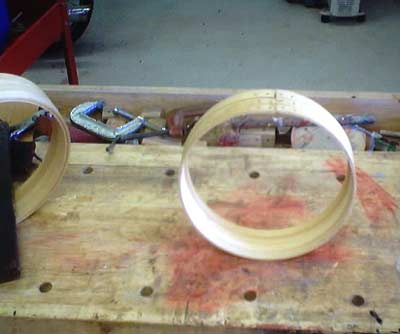
Pic 2: joining rings for shaping
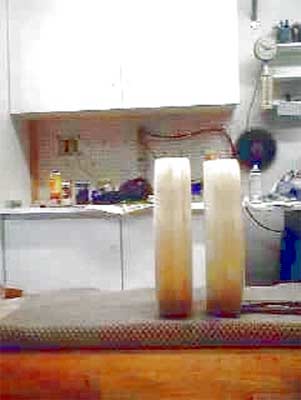
Pic 3: Showing airfoil shapes
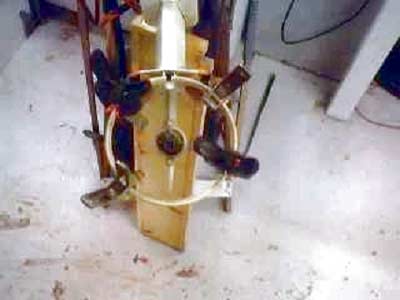
Pic 4: Test fit
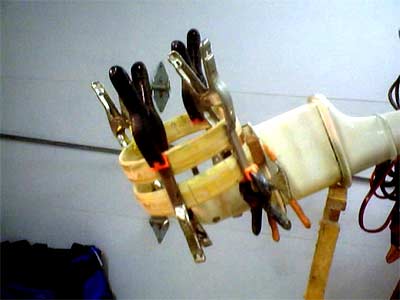
Pic 5: Alligning for fitting of ring struts
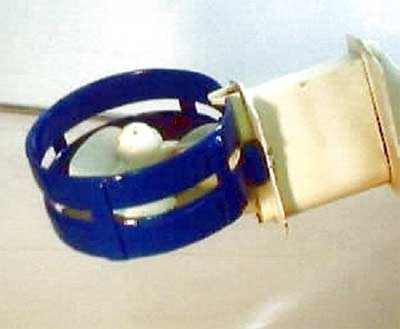
Pic 6: Finished nozzle
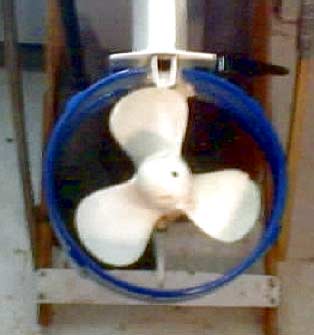
Pic 7: End view finished nozzle
How does it work? Stay tuned, I’m
launching the boat next week and will do some tests.
Terry
Lesh (5/1/04)
Postscript:
I finally got my Baymaster 18 launched
and rigged at our moorage in Baker Bay at Dorena Lake, Oregon.
I was very excited to make some test runs with the new nozzle.
The plan was to do a number tests: Gps speed runs at different
throttle settings, rpm readings at different throttle settings,
and fuel consumption/speed runs.
My questions where: Does the nozzle
make for higher hull speed? Does the nozzle make for higher hull
speeds at lower throttle settings? How does the nozzle affect
engine rpm at different throttle settings (all compared to running
without the nozzle).
Equipped with a full tank of fuel,
my gps and my Spirometer (a small handheld virbratach made in
Germany for checking rpms from 800 to 50K on any rotating engine.
It works like a tuning instrument for stringed instruments. It
has a fine wire on a small reel with an rpm dial indicator. It
works by placing the meter on the engine and turning the dial
until the wire reaches its highest oscillation, then you read
the rpm off the dial.)
With my wife Patricia, at the tiller
we set out. First I did some static dock tests just see what the
thrust might me like. My first impression was that when I engaged
the gear at low speed the boat immediately kicked forward (I have
only forward on my 4hp Sailmaster) with quite a noticeable lurch.
Applying more throttle noticeably increased tension on the dock
lines. Interestingly the engine would not rev up as quickly and
easily as without the nozzle. I got more excited. This is going
to be awesome! I figured the engine wouldn’t rev as freely
in the nozzle mode as it did without because there was much more
torque resistance in the water--?
I noticed this too as we got under
way, inside the harbor it took less throttle to move out past
the speed limit buoy, and the engine seemed to be laboring somewhat.
After leaving the harbor I set about using different throttle
speeds, reading the gps, reading the Spirometer, and making notes.
Things were looking impressive, so I got impatient and decided
open her up. Suddenly the engine started to labor a lot harder,
there was a funny sound from the hull then a shudder then the
engine took off went immediately to its usual full speed sound.
I looked behind me and was aghast to see my beautifully crafted
nozzle shattered in pieces and strewn out behind the boat!
We stopped, tilted up the engine,
and yes there nothing left of the nozzle on the engine. Not a
single piece. It had fairly well exploded and disintegrated totally.
We picked up a piece out of the lake for diagnosis. What apparently
happened is that the nozzle twisted so badly it got into the prop
which tore it all to hell. Man there are forces down there I had
no clue about. When I installed the nozzle I hand tested it for
rigidity and twist stability. It seemed pretty strong, though
it was a little flexible. It was securely mounted with 8 stainless
bolts, two on each side of both of the rings to the cavitation
plate on the engine.
Needless to say my notes were incomplete,
my tests did not get finished, and I couldn’t make any comparisons.
However my gps record showed a highest speed of 6.3 mph. We did
some speed, throttle and rpm tests sans nozzle and found our speed
was about 5.3 to 5.5 mph downwind (about 15 knots) and 4.3 to
4.5 upwind. The rpms were 3800 at about ¾ throttle and
around 4100 at full throttle.
So what are the results and what
did I learn from this. First I am not going through 8000 prototypes
like the vacuum cleaner guy from Australia on TV to get the final
model. However from 5.3 mph to 6.3mph is a 20% gain in overall
hull speed. This is really all the test data have. Impressions
are that the nozzle does make for an increase of thrust, and a
greater torque load on the engine with a resulting increase in
hull speed at lower throttle settings. It appears that messing
around with this sort of thing also requires some experimentation
with props. Lastly that there is a lot going on down there when
the prop is working, forces I had not anticipated at all. I think
the Spirometer is very accurate, and I see that my engine is not
quite developing its full hp as it is rated 4hp @ 4500, with an
operating range of 4000 to 5000 rpm. I’m within the range,
but not peaking out.
I’m not going to go through
the pains taking labor to make another one, it would have to be
made of much stronger materials than wood and fiberglass. Would
I buy one? If I am good and can save my allowance to shell out
the $130 for a real one, I might, although Patricia says she doesn’t
mind going slow (like 6.3 mph is fast?) as she can enjoy the view.
I would like to see articles from
others who buy these things, or at least posts if anyone has tried
them. I think they are worth experimenting with.
Terry
Lesh (6/2/04)

|

